fuel cover PONTIAC G8 2009 Owners Manual
[x] Cancel search | Manufacturer: PONTIAC, Model Year: 2009, Model line: G8, Model: PONTIAC G8 2009Pages: 356, PDF Size: 1.83 MB
Page 94 of 356
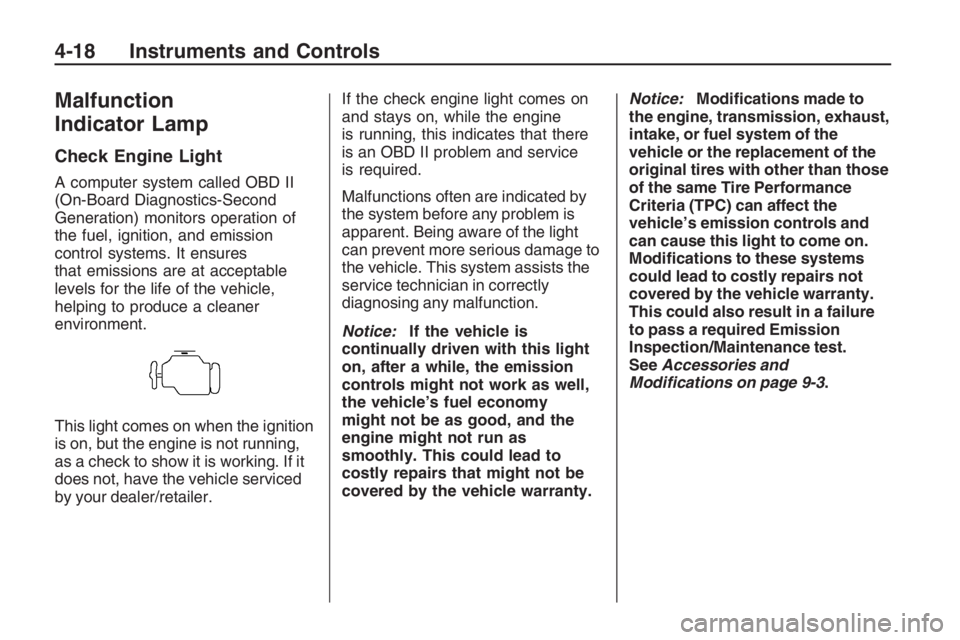
Malfunction
Indicator Lamp
Check Engine Light
A computer system called OBD II
(On-Board Diagnostics-Second
Generation) monitors operation of
the fuel, ignition, and emission
control systems. It ensures
that emissions are at acceptable
levels for the life of the vehicle,
helping to produce a cleaner
environment.
This light comes on when the ignition
is on, but the engine is not running,
as a check to show it is working. If it
does not, have the vehicle serviced
by your dealer/retailer.If the check engine light comes on
and stays on, while the engine
is running, this indicates that there
is an OBD II problem and service
is required.
Malfunctions often are indicated by
the system before any problem is
apparent. Being aware of the light
can prevent more serious damage to
the vehicle. This system assists the
service technician in correctly
diagnosing any malfunction.
Notice:If the vehicle is
continually driven with this light
on, after a while, the emission
controls might not work as well,
the vehicle’s fuel economy
might not be as good, and the
engine might not run as
smoothly. This could lead to
costly repairs that might not be
covered by the vehicle warranty.Notice:Modi�cations made to
the engine, transmission, exhaust,
intake, or fuel system of the
vehicle or the replacement of the
original tires with other than those
of the same Tire Performance
Criteria (TPC) can affect the
vehicle’s emission controls and
can cause this light to come on.
Modi�cations to these systems
could lead to costly repairs not
covered by the vehicle warranty.
This could also result in a failure
to pass a required Emission
Inspection/Maintenance test.
SeeAccessories and
Modifications on page 9-3.
4-18 Instruments and Controls
Page 97 of 356
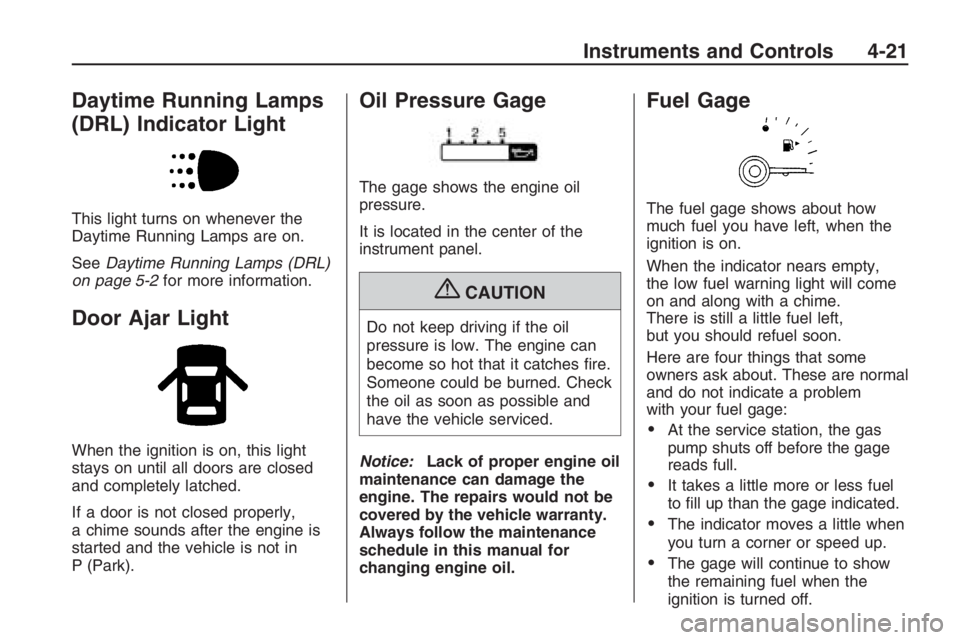
Daytime Running Lamps
(DRL) Indicator Light
This light turns on whenever the
Daytime Running Lamps are on.
SeeDaytime Running Lamps (DRL)
on page 5-2for more information.
Door Ajar Light
When the ignition is on, this light
stays on until all doors are closed
and completely latched.
If a door is not closed properly,
a chime sounds after the engine is
started and the vehicle is not in
P (Park).
Oil Pressure Gage
The gage shows the engine oil
pressure.
It is located in the center of the
instrument panel.
{CAUTION
Do not keep driving if the oil
pressure is low. The engine can
become so hot that it catches �re.
Someone could be burned. Check
the oil as soon as possible and
have the vehicle serviced.
Notice:Lack of proper engine oil
maintenance can damage the
engine. The repairs would not be
covered by the vehicle warranty.
Always follow the maintenance
schedule in this manual for
changing engine oil.
Fuel Gage
The fuel gage shows about how
much fuel you have left, when the
ignition is on.
When the indicator nears empty,
the low fuel warning light will come
on and along with a chime.
There is still a little fuel left,
but you should refuel soon.
Here are four things that some
owners ask about. These are normal
and do not indicate a problem
with your fuel gage:
At the service station, the gas
pump shuts off before the gage
reads full.
It takes a little more or less fuel
to �ll up than the gage indicated.
The indicator moves a little when
you turn a corner or speed up.
The gage will continue to show
the remaining fuel when the
ignition is turned off.
Instruments and Controls 4-21
Page 167 of 356
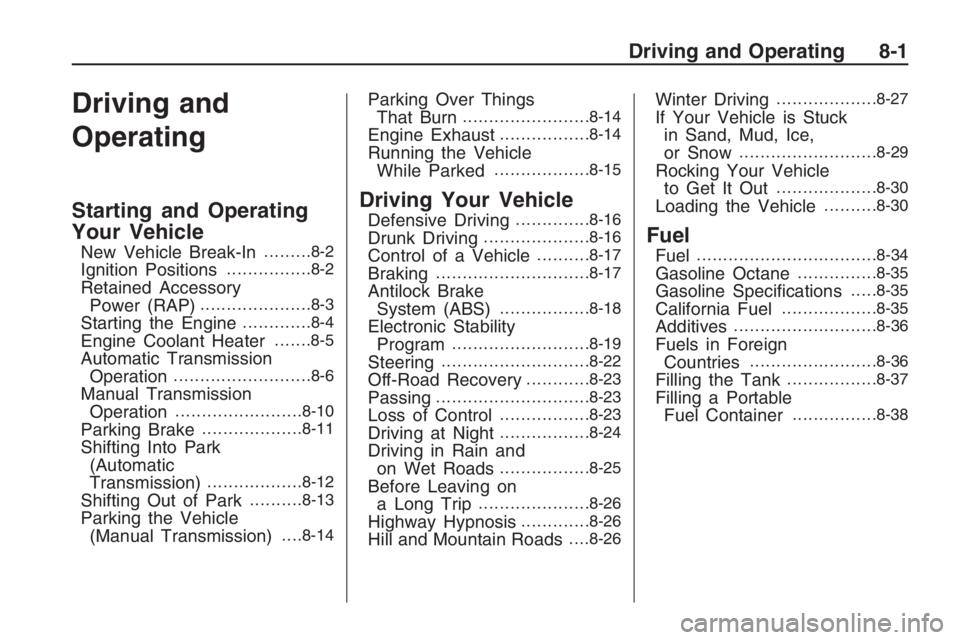
Driving and
Operating
Starting and Operating
Your Vehicle
New Vehicle Break-In.........8-2
Ignition Positions................8-2
Retained Accessory
Power (RAP).....................8-3
Starting the Engine.............8-4
Engine Coolant Heater.......8-5
Automatic Transmission
Operation..........................8-6
Manual Transmission
Operation........................8-10
Parking Brake...................8-11
Shifting Into Park
(Automatic
Transmission)
..................8-12
Shifting Out of Park..........8-13
Parking the Vehicle
(Manual Transmission). . . .8-14
Parking Over Things
That Burn........................8-14
Engine Exhaust.................8-14
Running the Vehicle
While Parked..................8-15
Driving Your Vehicle
Defensive Driving..............8-16
Drunk Driving....................8-16
Control of a Vehicle..........8-17
Braking.............................8-17
Antilock Brake
System (ABS).................8-18
Electronic Stability
Program..........................8-19
Steering............................8-22
Off-Road Recovery............8-23
Passing.............................8-23
Loss of Control.................8-23
Driving at Night.................8-24
Driving in Rain and
on Wet Roads.................8-25
Before Leaving on
a Long Trip.....................8-26
Highway Hypnosis.............8-26
Hill and Mountain Roads. . . .8-26
Winter Driving...................8-27
If Your Vehicle is Stuck
in Sand, Mud, Ice,
or Snow
..........................8-29
Rocking Your Vehicle
to Get It Out...................8-30
Loading the Vehicle..........8-30
Fuel
Fuel..................................8-34
Gasoline Octane...............8-35
Gasoline Speci�cations.....8-35
California Fuel..................8-35
Additives...........................8-36
Fuels in Foreign
Countries........................8-36
Filling the Tank.................8-37
Filling a Portable
Fuel Container................8-38
Driving and Operating 8-1
Page 171 of 356

Wait at least 15 seconds between
each try, to allow the cranking
motor to cool. When the engine
starts, let go of the key and
accelerator. If the vehicle starts
brie�y but then stops again,
repeat the procedure. This clears
the extra gasoline from the
engine. Do not race the engine
immediately after starting it.
Operate the engine and
transmission gently until the oil
warms up and lubricates all
moving parts.
Notice:The engine is designed
to work with the electronics
in the vehicle. If you add electrical
parts or accessories, you could
change the way the engine
operates. Before adding electrical
equipment, check with your
dealer/retailer. If you do not, the
engine might not perform
properly. Any resulting damage
would not be covered by the
vehicle warranty.Engine Coolant Heater
The engine coolant heater, if
available, can help in cold weather
conditions at or below 0°F (−18°C)
for easier starting and better fuel
economy during engine warm-up.
Plug in the coolant heater at least
four hours before starting your
vehicle. An internal thermostat in the
plug-end of the cord will prevent
engine coolant heater operation at
temperatures above 0°F (−18°C).
To Use The Engine Coolant
Heater
1. Turn off the engine.
2. Open the hood and unwrap the
electrical cord.
The electrical cord is located on
the driver side of the engine
compartment, behind the
air cleaner for V8 models.
The electrical cord is located
on the passenger side of
the engine compartment, behind
the engine compartment fuse
block for V6 models.3. Plug it into a normal, grounded
110-volt AC outlet.
{CAUTION
Plugging the cord into an
ungrounded outlet could cause an
electrical shock. Also, the wrong
kind of extension cord could
overheat and cause a �re. You
could be seriously injured. Plug
the cord into a properly grounded
three-prong 110-volt AC outlet.
If the cord will not reach, use a
heavy-duty three-prong extension
cord rated for at least 15 amps.
4. Before starting the engine, be
sure to unplug and store the
cord as it was before to keep
it away from moving engine
parts. If you do not it could be
damaged.
Driving and Operating 8-5
Page 173 of 356

ease pressure on the shift lever and
push the shift lever all the way
into P (Park) while maintaining brake
application. Then press the shift
lever button and move the shift lever
into another gear. SeeShifting
Out of Park on page 8-13.
Notice:Shifting to R (Reverse)
while the vehicle is moving
forward could damage the
transmission. The repairs would
not be covered by the vehicle
warranty. Shift to R (Reverse)
only after the vehicle is stopped.
R (Reverse):Use this gear to
back up.
At low vehicle speeds, R (Reverse)
can also be used to rock the vehicle
back and forth to get out of snow, ice,
or sand without damaging the
transmission. SeeIf Your Vehicle is
Stuck in Sand, Mud, Ice, or Snow on
page 8-29for additional information.N (Neutral):In this position, the
engine does not connect with
the wheels. To restart the engine
when the vehicle is already moving,
use N (Neutral) only.
{CAUTION
Shifting into a drive gear while the
engine is running at high speed is
dangerous. Unless your foot is
�rmly on the brake pedal, the
vehicle could move very rapidly.
You could lose control and hit
people or objects. Do not shift into
a drive gear while the engine is
running at high speed.
Notice:Shifting out of P (Park)
or N (Neutral) with the engine
running at high speed may
damage the transmission. The
repairs would not be covered by
the vehicle warranty. Be sure
the engine is not running at high
speed when shifting the vehicle.D (Drive):This position is for normal
driving. It provides the best fuel
economy. If more power is needed
for passing, and the vehicle is:
Going less than 35 mph
(55 km/h), push the accelerator
pedal about halfway down.
Going about 35 mph (55 km/h) or
more, push the accelerator all the
way down.
Downshifting the transmission in
slippery road conditions could result
in skidding, see Skidding under
Loss of Control on page 8-23
Notice:Spinning the tires or
holding the vehicle in one place
on a hill using only the
accelerator pedal may damage
the transmission. If you are stuck,
do not spin the tires. When
stopping on a hill, use the brakes
to hold the vehicle in place.
Driving and Operating 8-7
Page 201 of 356

Gasoline Octane
If the vehicle has a V8 engine, use
regular unleaded gasoline with a
posted octane rating of 87 or higher.
If the octane rating is less than 87,
you might notice an audible knocking
noise when you drive, commonly
referred to as spark knock. If this
occurs, use a gasoline rated at 87
octane or higher as soon as possible.
If you are using gasoline rated at 87
octane or higher and you hear heavy
knocking, the engine needs service.
If the vehicle has the 3.6L V6 engine
(VIN Code 7), use regular unleaded
gasoline with a posted octane rating
of 87 or higher. For best performance
or trailer towing, you could choose
to use middle grade 89 octane
unleaded gasoline. If the octane
rating is less than 87, you might
notice an audible knocking noise
when you drive, commonly referredto as spark knock. If this occurs,
use a gasoline rated at 87 octane
or higher as soon as possible. If you
are using gasoline rated at
87 octane or higher and you hear
heavy knocking, the engine needs
service.
Gasoline Speci�cations
At a minimum, gasoline should
meet ASTM speci�cation D 4814
in the United States or
CAN/CGSB-3.5 or 3.511 in Canada.
Some gasolines contain an
octane-enhancing additive called
methylcyclopentadienyl manganese
tricarbonyl (MMT). We recommend
against the use of gasolines
containing MMT. SeeAdditives on
page 8-36for additional information.
California Fuel
If the vehicle is certi�ed to meet
California Emissions Standards, it is
designed to operate on fuels that
meet California speci�cations. See
the underhood emission control
label. If this fuel is not available in
states adopting California emissions
standards, the vehicle will operate
satisfactorily on fuels meeting federal
speci�cations, but emission control
system performance might be
affected. The malfunction indicator
lamp could turn on and the vehicle
might fail a smog-check test. See
Malfunction Indicator Lamp on
page 4-18. If this occurs, return to
your authorized dealer/retailer for
diagnosis. If it is determined that the
condition is caused by the type of
fuel used, repairs might not be
covered by the vehicle warranty.
Driving and Operating 8-35
Page 202 of 356
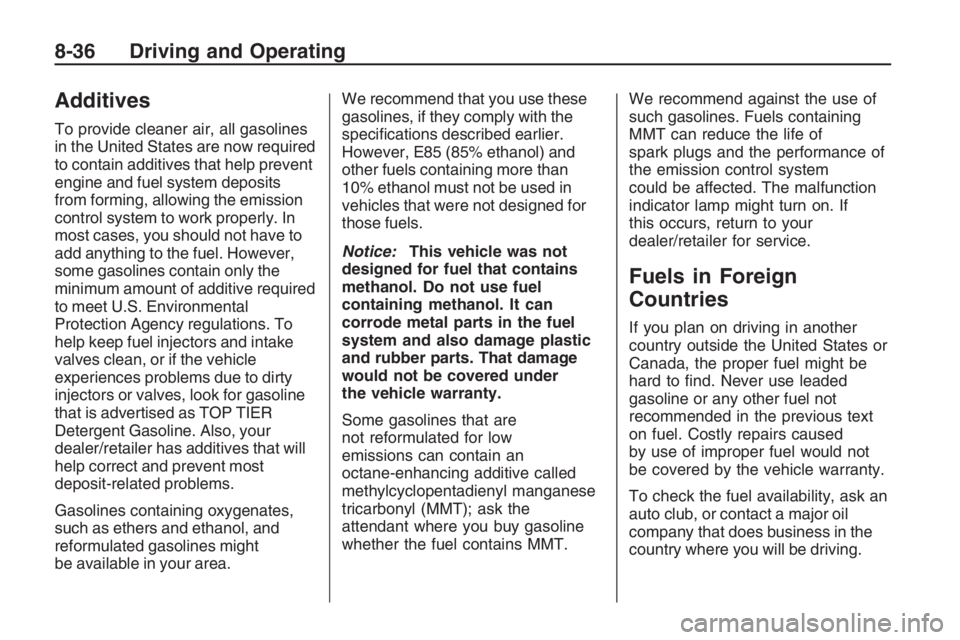
Additives
To provide cleaner air, all gasolines
in the United States are now required
to contain additives that help prevent
engine and fuel system deposits
from forming, allowing the emission
control system to work properly. In
most cases, you should not have to
add anything to the fuel. However,
some gasolines contain only the
minimum amount of additive required
to meet U.S. Environmental
Protection Agency regulations. To
help keep fuel injectors and intake
valves clean, or if the vehicle
experiences problems due to dirty
injectors or valves, look for gasoline
that is advertised as TOP TIER
Detergent Gasoline. Also, your
dealer/retailer has additives that will
help correct and prevent most
deposit-related problems.
Gasolines containing oxygenates,
such as ethers and ethanol, and
reformulated gasolines might
be available in your area.We recommend that you use these
gasolines, if they comply with the
speci�cations described earlier.
However, E85 (85% ethanol) and
other fuels containing more than
10% ethanol must not be used in
vehicles that were not designed for
those fuels.
Notice:This vehicle was not
designed for fuel that contains
methanol. Do not use fuel
containing methanol. It can
corrode metal parts in the fuel
system and also damage plastic
and rubber parts. That damage
would not be covered under
the vehicle warranty.
Some gasolines that are
not reformulated for low
emissions can contain an
octane-enhancing additive called
methylcyclopentadienyl manganese
tricarbonyl (MMT); ask the
attendant where you buy gasoline
whether the fuel contains MMT.We recommend against the use of
such gasolines. Fuels containing
MMT can reduce the life of
spark plugs and the performance of
the emission control system
could be affected. The malfunction
indicator lamp might turn on. If
this occurs, return to your
dealer/retailer for service.
Fuels in Foreign
Countries
If you plan on driving in another
country outside the United States or
Canada, the proper fuel might be
hard to �nd. Never use leaded
gasoline or any other fuel not
recommended in the previous text
on fuel. Costly repairs caused
by use of improper fuel would not
be covered by the vehicle warranty.
To check the fuel availability, ask an
auto club, or contact a major oil
company that does business in the
country where you will be driving.
8-36 Driving and Operating
Page 242 of 356

Fuses Usage
F14 Auxiliary Power
F15Outside Rearview
Mirrors
F16Sunroof/Automatic
Transmission
Shift Lock
F17 Sunroof
F18Automatic Occupant
Sensor
F19Driver Side Heated
Seat
F20Passenger Side
Heated Seat
F21Daytime Running
Lamps
F22Front Cigarette
Lighter
F23Steering Wheel
Controls Backlighting
F24 Power Window
FUSE
PULLERFuse PullerCircuit
BreakersUsage
B1 Spare
B2 Power Windows
B3 Power Seats
B4 Spare
Relays Usage
R1Retain Accessory
Power 1
R2 Door Locks
R3Passenger Side
Door Lock
R4 Spare
R5 Trunk Release
R6 Driver Side Lock
R7Retain Accessory
Power 2
R8 Accessory
R9 Blower
R10 Spare
R11Daytime Running
Lamps
R12 Fuel Pump
Engine Compartment
Fuse Block
To open the fuse block cover,
remove the clip on cover.
Notice:Spilling liquid on any
electrical components on
the vehicle may damage it.
Always keep the covers on any
electrical component.
9-38 Vehicle Service and Care
Page 245 of 356
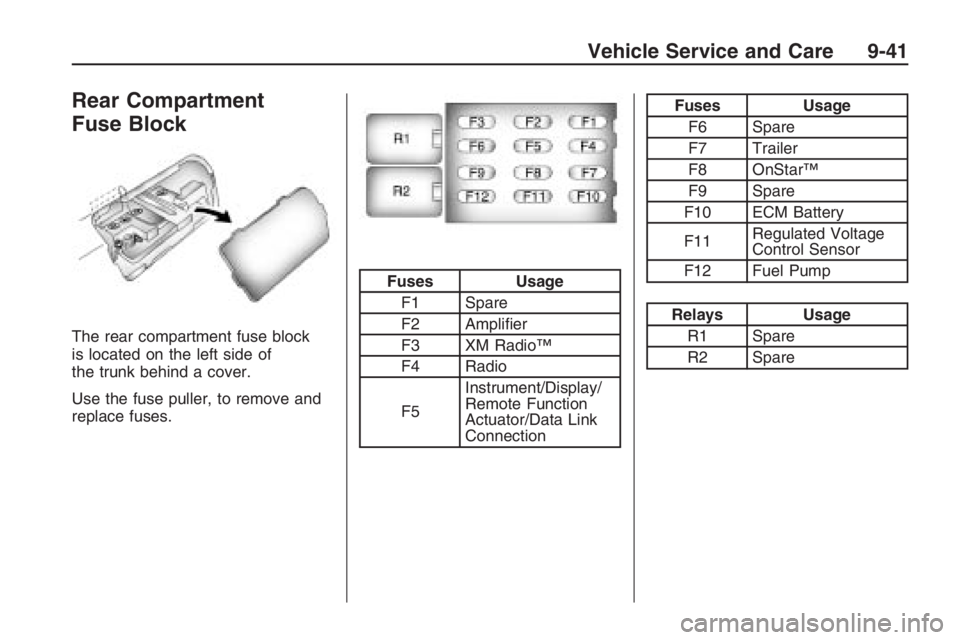
Rear Compartment
Fuse Block
The rear compartment fuse block
is located on the left side of
the trunk behind a cover.
Use the fuse puller, to remove and
replace fuses.
Fuses Usage
F1 Spare
F2 Ampli�er
F3 XM Radio™
F4 Radio
F5Instrument/Display/
Remote Function
Actuator/Data Link
Connection
Fuses Usage
F6 Spare
F7 Trailer
F8 OnStar™
F9 Spare
F10 ECM Battery
F11Regulated Voltage
Control Sensor
F12 Fuel Pump
Relays Usage
R1 Spare
R2 Spare
Vehicle Service and Care 9-41
Page 293 of 356

6. Press the select button and
move the transmission gear
selector to the N (Neutral)
position (G).
7. Release the lever (F).
8. After the vehicle has been
moved, align the shift lock
manual release cover plate (D)
and install the retainer (E) so the
automatic transmission can
operate properly.
9. Place the trim panel (A) and the
wires in their original position
and gently press down around
the outside until it clicks in place.
10. Check the operation of the
switches (B) before operating
the vehicle.
The transmission selector locks if it
is moved back to the P (Park)
position.Recreational Vehicle
Towing
Notice:Dolly towing or dinghy
towing the vehicle may cause
damage because of reduced
ground clearance. Always put the
vehicle on a �atbed truck.
The vehicle was neither designed
nor intended to be towed with any of
its wheels on the ground. If the
vehicle must be towed, see “Towing
Your Vehicle” earlier in this section.
Towing a Trailer
{CAUTION
The driver can lose control when
pulling a trailer if the correct
equipment is not used or the
vehicle is not driven properly. For
example, if the trailer is too heavy,
the brakes may not work well — or
even at all. The driver and
(Continued)
CAUTION (Continued)
passengers could be seriously
injured. The vehicle may also be
damaged; the resulting repairs
would not be covered by the
vehicle warranty. Pull a trailer only
if all the steps in this section have
been followed. Ask your
dealer/retailer for advice and
information about towing a trailer
with the vehicle.
Your vehicle can tow a trailer if it is
equipped with the proper trailer
towing equipment. To identify the
trailering capacity of your vehicle,
you should read the information
in “Weight of the Trailer” that
appears later in this section.
Trailering is different than just
driving your vehicle by itself.
Trailering means changes in
handling, acceleration, braking,
durability and fuel economy.
Vehicle Service and Care 9-89